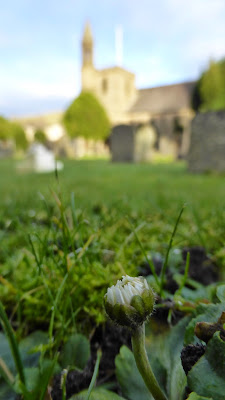You can read the report I made about the talk for Green Christian here and more important see the videos of the speakers here:
Dave Bookless ... Daid Nussboaum (WWF) .... Simon Stuart (IUCN)
I left home in good time to walk the 1.5 miles to the station. I saw my first field-fares for the year in a hawthorn tree. I would have missed seeing them if I had been driving.
 |
| I looked back over the railway bridge over the Settle-Carlisle Line. The train I would be catching would be coming down here in half an hour. |
 |
| At Settle as the train arrives. At Leeds I almost bought a book about using cartoons in presentations. but decided to get it later. |
At London I visited Westminster Cathedral (Catholic) for the first time, and looked at all the little chapels within the cathedral. I bought a cup of tea and cake.
Then I walked to Westminster Central Hall (Methodist) "It's closed now said a man at the entrance. People were pouring out - it had been used for an Education Conference that day.
I crossed the road to Westminster Abbey.. in time to go to evening prayer at 5pm. A privelege.
After the prayers I gave two of the priests copies of the "Saving Wildlife and biodiversity" leaflet.
 |
| Outside Westminster Abbey |
 |
| Westminster Abbey |
 |
| Here are the three speakers - Simon Stuart, David Bookless and David Nussbaum |
I hope they are going to put a video of the evening on the Jubilee Centre Website. eventually.
 |
| David Bookless gave highlights form his paper "The Bible and Biodiversity" You can read the paper here |
 |
| Simon Stuart of IUCN. He pointed out that of the 11 species of animal mentioned in the end of Job, 7 or them were now extinct in that part of the world. |
 |
| Brian Cuthbertson |
Brain Cuthbertson told us of the plan to carry out professional / detailed wildlife surveys of all the graveyards in London
 |
| Afterwards I met the A Rocha Director of Conservation, |
I went to stay at St Paul's Youth Hostel - It is in the old St Paul's Choir School. I have been there before. I like it it has more character than some of the newer ones built in central London
After I had booked in, I left my bag I went for a walk along the Millennium Bridge outside.
I ate some "Middle Eastern salad" that I had
bought cheap the day before at the end of its sell by date. It was delicious.
 |
| Gulls on the Millennium Bridge, London |
 |
| View of the Shard |
 |
| St Pauls |
 |
| Under the conifer tree was a man feeding the grey squirrels |
I had good exercise walking the big distances at the Olympic site, to the swimming pool.
 |
| The Olympic Swimming Pool at Stratford |
 |
| View of display of model buses from the Swimming Pool |
 |
| There was lots of Purple Moor-grass that had been planted in tubs. The Swimming Pool is behind. |
 |
| I enjoyed travelling on the new tube. (Reflection in window). I enjoyed watching all the people on the train- but you can't really photograph them and then put them on the internet.. |
 |
| Walking the length of the train at King's Cross platform 1. Lots of exercise! |

































